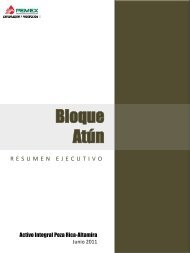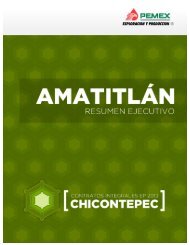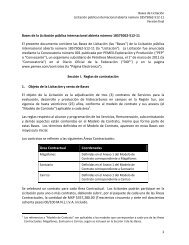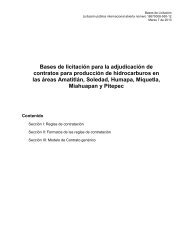1 - Contratos Integrales EP
1 - Contratos Integrales EP
1 - Contratos Integrales EP
You also want an ePaper? Increase the reach of your titles
YUMPU automatically turns print PDFs into web optimized ePapers that Google loves.
Integrated Contract <strong>EP</strong>: Pitepec<br />
Index<br />
Introduction. .............................................................................................................................3<br />
Basin description......................................................................................................................5<br />
Main Features...........................................................................................................................9<br />
Exploration and Development History.............................................................................15<br />
Production by field and reserves ......................................................................................18<br />
Infrastructure and Hydrocarbons handling....................................................................20<br />
Drilling history ..........................................................................................................................22
Introduction<br />
Integrated Contract <strong>EP</strong>: Pitepec<br />
The integrated contract area Pitepec is located in the northeast part of the “Activo<br />
Integral Aceite Terciario del Golfo” surface, covering an area of 230 Km 2 ; it is 76 Km NNW<br />
of Poza Rica, Veracruz.<br />
Location of Pitepec Contract Area<br />
Geologically, it is located in the south -‐ center of the Tampico -‐ Misantla basin. The main<br />
field in this area is Aragón; it was discovered in 1943; gas and oil shows were observed<br />
during drilling of Aragón-‐2 well, which was deemed a dry non-‐producer, hence it was<br />
plugged.<br />
On this integrated area 22 wells have been drilled, 11 are shut-‐in, 6 are plugged and 5 are<br />
in operation. Maximum production was 150 bpd of oil with 6 active well in February 2012;<br />
currently the (30/06/12) production is 61 bpd oil, its cumulative production is 822.807 Mbl<br />
oil and 583.005 MMpc gas. The oil type is light crude, with a density ranging between 32<br />
to 40° API; the bottomhole pressure measured recently in the Aragón-‐191 well (June<br />
2012) was 73.8 Kg/cm 2 at a depth of 1,040 m.. The current production system in the<br />
area is rod pumping. The average depth of the tertiary reservoirs is 1,050 m.
Integrated Contract <strong>EP</strong>: Amatitlán<br />
During drilling of the exploration wells in the Tamaulipas Superior, Tamaulipas Inferior,<br />
Pimienta and Tamán Mesozoic formations, gas shows were observed; oil impregnation<br />
was observed in the channel samples and cores.<br />
The following information was obtained from PVT analyses of various wells from the<br />
above formation in the Chicontepec Paleochannel area:<br />
• Chicontepec-‐2A Well (located 5.0 Km southwest of area).<br />
Tamaulipas Superior Formation: 37.3 °API Oil, gas solubility at initial pressure relationship<br />
(Rsi), 168.70 m 3 /m 3 ; Oil Volume Factor (Bo), 1.5683 m 3 /m 3 ; and saturation pressure (Pb),<br />
206.70 Kg/cm 2 .<br />
• Presidente Miguel Alemán-‐772 Well (located 85 Km southeast of area).<br />
Tamaulipas Inferior Formation: 35.7 °API Oil; gas solubility at initial pressure relationship<br />
(Rsi), 179.50 m 3 /m 3 ; Oil Volume Factor (Bo), 1.6270 m 3 /m 3 ; a saturation pressure (Pb),<br />
215.20 Kg/cm 2 .<br />
• Caviar-‐1 Well (located 123 Km northeast of area).<br />
Pimienta Formation: 15.74 °API Oil; gas solubility at initial pressure relationship (Rsi),<br />
33.28 m 3 /m 3 ; Oil Volume Factor (Bo), 1.1659 m 3 /m 3 ; saturation pressure (Pb), 106.16<br />
Kg/cm 2 .<br />
• Furbero-‐106 Well (located 73 Km southeast of area).<br />
Tamán Formation: 37.11 °API Oil; gas solubility at initial pressure relationship (Rsi), 179.60<br />
m 3 /m 3 ; Oil Volume Factor (Bo), 1.8138 m 3 /m 3 ; saturation pressure (Pb), 175.10 Kg/cm 2 .
Basin Description<br />
Integrated <strong>EP</strong>:<br />
The Tampico -‐ Misantla basin is located in eastern Mexico and it spans from southern<br />
Tamaulipas to the central part of the state of Veracruz, along with a small part of the east<br />
side of the states of San Luis Potosí, Hidalgo and north of Puebla, down to the 200-‐m<br />
isobaths of the Gulf of Mexico's continental shelf.<br />
Location of Tampico – Misantla Basin.<br />
The crystalline basement is formed by igneous and metamorphic rock, their ages ranging<br />
from Permian to the middle Jurassic. In the sedimentary column of the Tampico-‐Misantla<br />
province, the following tectono-‐sequences are identified:<br />
First tectono-‐sequence (Synrift). Started in the Triassic (250My), with the deposition of<br />
continental clasts from alluvial and fluvial environment with some lava flowed from the<br />
5
Integrated <strong>EP</strong>:<br />
Huizachal formation, from the late Triassic age (Noriense-‐Retiense), over crystalline and<br />
metamorphic basements, later the Huayacocotla formation from the Lower Jurassic<br />
(Hettangiano-‐Pliensbachiano) was deposited, and it is a sandstones and shale sequence,<br />
from transgressive oceans. By the middle Jurassic, continental conditions were restored,<br />
with Clasts from the Cahuasas formation being deposited, by the end of this period, a new<br />
marine transgression commenced, and favored the deposition of oolithic limestone for<br />
the Huehuetepec formation (Bathonian), and sandy limestone with bioclasts and ooliths<br />
for the Tepexic formation (Callovian), which were overlain by calcareous and<br />
carbonaceous shale with plenty of organic matter, from the Santiago formation<br />
(Oxfordian), deposited on constrained, low-‐energy seas; as the marine transgression<br />
moved forward, carbonate ramps developed around the basement highs -‐ inside and on<br />
the edge of the former, sandy-‐clayey limestone and oolithic limestone from the San Pedro<br />
and San Andrés formations were deposited, (Kimmeridgian), respectively, and their lateral<br />
equivalents toward deeper waters, namely, the clayey limestones with scarce bioclasts<br />
and oolites (Chipoco formation) and basin black clayey limestones (Tamán formation).<br />
The transgressive sea conditions continued so that during the Tithonian-‐Portlandian, a<br />
maximum flooding surface would occur, with most of the basement highs being left in<br />
underwater conditions. During that time, clayey-‐carbonaceous limestones were<br />
deposited, (rich in organic matter) from the Pimienta formation, from a relatively-‐deep-‐<br />
water environment, which is present throughout the region and only in the parts<br />
emerging from the basement, which were under coastal and/or shoreline conditions; La<br />
Casita formation was deposited, which is constituted by glauconitic sandstones.<br />
Passive Margin Tectono-‐sequence. The marine transgression carried on and ultimately<br />
flooded all of the basement highs, it deposited on the internal parts, limestones and<br />
dolomites, while on the edges, the organic-‐reefal growths development commenced. At<br />
the same time, and due to the thermal subsidence, the lower areas deepened, giving rise<br />
to deep sea basins, where the three members of the Tamaulipas Inferior formation were<br />
deposited (calcarenithic member, bentonitic member and creamy limestone member)<br />
corresponding to the Berriasian-‐Barremian age. During the Aptian stage, the Otates<br />
horizon formation deposition occurred, which is considered to be a condensed sequence.<br />
During the Albian, along the entire Tuxpan platform a reef edge, roughly 1400 m thick,<br />
which gave rise to lagoon facies on the inside of the platform, whereas for the reef front,<br />
the Tamabra formation, featuring proximal, mean and distal slope facies, developed due<br />
to the reefal denudation, and changes facies with the chalky limestone Tamaulipas<br />
Superior formation.<br />
6
Integrated <strong>EP</strong>:<br />
By the end of the Cenomanian, the platform remained under subaerial conditions by a<br />
regressive marine pulse, which was followed by a new transgressive event allowing the<br />
deposition both in lagoon facies and in the mean, distal slope and basin of the Turonian<br />
Agua Nueva (black clayey limestones with black shales interbeddings), Coniacian-‐<br />
Santonian San Felipe (greenish-‐grey clayey limestone with abundant olive green bentonite<br />
interbeddings) and Campanian-‐Maastrichtian Méndez (clayey limestones and green/red<br />
marls) formations; the period of this tectono-‐sequence ended with the deposition of the<br />
last formation.<br />
Eventos<br />
Tectónicos<br />
Ambientes<br />
sedimentarios<br />
Geologic column for the Tampico-‐Misantla basin with reservoir rock, source rock<br />
(unconventional reservoirs), tectonic events and sedimentary environments.<br />
The foreland basin tectono-‐sequence is characterized by the onset of the Sierra Madre<br />
Oriental's (SMO) uplift, which gave rise to a greater contribution of terrigenous material<br />
7
Integrated <strong>EP</strong>:<br />
sediments; these marine Cenozoic depositions were originally defined as Tampico-‐<br />
Misantla Basin by López-‐Ramos (1956).<br />
The ongoing uplift of the SMO left very narrow coastal plains and continental shelves,<br />
hence the coastal systems would go from a prodelta to a slope, and where the transport<br />
of sediments by means of turbidity currents prevailed, there would be flow of debris and<br />
landslides, which would produce deposition of submarine fans at the bottom of the<br />
seafloor (basin), overlapping each other and generating submarine erosion during their<br />
development.<br />
By the end of the Cenozoic, deltaic environments prevailed.<br />
Tuxpan<br />
Poza Rica<br />
Tecolutla<br />
Tertiary Sedimentary model (Paleogene and Neogene). Note that delta environments<br />
were deposited above the Chicontepec formation<br />
8
Main Features<br />
Integrated Contract <strong>EP</strong>: Amatitlán<br />
The main producing formation is the Chicontepec formation, having evidence of<br />
production in the Pimienta formation (Upper Jurassic).<br />
The reservoirs in this Contract Area are located in combined, structural (anticlines with<br />
subtle dips with four-‐direction closure) and stratigraphic traps.<br />
This Contract Area features the Aragón-‐2, Aragon-‐1001, Pedregosa-‐1 and Tlacolula-‐10<br />
exploration wells; slight oil impregnations were evidenced in the cutting samples;<br />
attractive gas shows were found in the Agua Nueva, Tamabra, Tamaulipas Superior<br />
and Tamán formations.<br />
In the Aragón-‐2 well, slight oil shows were observed in the Agua Nueva formation, one<br />
core without oil impregnations was taken, no production tests were performed and the<br />
Cretaceous channel samples did not exhibit oil impregnations.<br />
In the Aragón-‐1001 well, slight oil and gas shows were observed in the Tamaulipas<br />
Superior and Pimienta formations, nine cores without oil impregnations was taken, no<br />
production tests were performed and the Cretaceous cutting samples exhibited slight oil<br />
impregnations from San Felipe and Tamaulipas Superior formations.<br />
In the Pedregosa-‐1 well, high gas readings were registered at the Taman formation; no<br />
production tests were performed; two cores were cut from the Agua Nueva formation<br />
with poor oil impregnation on the fracture planes; the channel samples exhibited a slight<br />
oil impregnation from the Agua Nueva and Tamaulipas Superior formations.<br />
In the Tlacolula-‐10 well, gas shows were observed during the drilling, little oil and sal<br />
water in the Agua Nueva formation and strong gas and oil shows in the Tamaulipas<br />
Superior formation. In the #20 core (2300 -‐ 2306.3 m) in the Tamaulipas Superior<br />
formation, traces of oil and a strong smell of gas were detected; no impregnations in<br />
channel samples were reported.
Integrated <strong>EP</strong>:<br />
Two formation tests were conducted in the Tamaulipas Superior formation, 50 meters of<br />
oil with plenty of gas and 75 meters of gasified mud were recovered from the production<br />
tubing (TP, in Spanish).<br />
Below are some comments on the events which occurred during drilling in the<br />
Chicontepec formation rocks:<br />
In the Galo-‐1 well, gas shows were observed in the low magnitude mud and in the regular<br />
magnitude channel samples during the drilling. Cores were cut from the Chicontepec<br />
Medio formation (8), showing light oil impregnation. The channel samples exhibited poor<br />
oil impregnation in the Aragón, Chicontepec Medio and Basal formations.<br />
A production test was performed in Chicontepec Medio, resulting in a production of 13<br />
bpd oil, 0% water and a GOR of 100m 3 /m 3 .<br />
In the Aragón-‐134 well, no gas shows were detected while drilling. Four cores were cut in<br />
the Chicontepec formation, with slight oil impregnation and residual organic matter<br />
(gilsonite). The channel samples from the Chicontepec Medio and Inferior formation had<br />
light oil impregnation stains.<br />
Four production tests with hydraulic fracturing were performed in the Chicontepec Canal<br />
formation, the first two tests produced 100% water; in the third test, the 815-‐860 m<br />
interval produced 14 bpd oil, 71% water and GOR 180m 3 /m 3 ; finally the fourth test in the<br />
815-‐860 m, 874-‐885 m and 1100-‐1105 m intervals produced 14 bpd oil, 71% water and<br />
180m 3 /m 3 GOR.<br />
In the Tlacolula-‐446 well, no gas shows were observed while drilling. Three cores were cut,<br />
exhibiting light yellow oil impregnations. The channel samples from Chicontepec Medio<br />
and Chicontepec Inferior formation showed light oil.<br />
Four production tests were conducted in the Chicontepec Canal formation with hydraulic<br />
fracturing, two of them with production: one in the 1470-‐1490 m interval, with a<br />
production of 7 bpd oil, 22% water and GOR 125m 3 /m 3 and the other test in the 811-‐825<br />
m interval with a production of 5 bpd oil, 92% water and GOR 186m 3 /m 3 .<br />
In the Aragón-‐2 well, light gas and oil shows were observed during drilling through the<br />
Chicontepec Medio formation. The channel samples from the Chicontepec Superior<br />
formation showed light oil impregnation.<br />
10
No production tests were conducted.<br />
Integrated <strong>EP</strong>:<br />
In the Aragón-‐78 well, no gas shows were observed during drilling. No cores were cut in<br />
the Tertiary formation and the channel samples did not exhibit any impregnation.<br />
Two production tests with hydraulic fracturing were conducted in the Chicontepec Medio<br />
formation; in the first test a treatment fluid volume of 342 m 3 was recovered, with 7 m 3<br />
remaining in the well; this interval was deemed an un-‐economic producer and the second<br />
test yield an estimated production of 31 bpd oil.<br />
In the Ayacaxtla-‐1 well, no gas shows were observed while drilling. 26 cores were cut, 20<br />
in the Chicontepec Medio formation and 6 in Chicontepec Superior, with poor light and<br />
residual oil impregnation, respectively. The channel samples had poor light oil and asphalt<br />
impregnation in the Chicontepec Superior, Medio e Inferior formation.<br />
Three production tests with hydraulic fracturing were performed, the first in the<br />
Chicontepec Inferior formation at the 1295-‐1305 m and 1315-‐1330 m intervals, the drilling<br />
flowed 80% salt water; this interval was deemed non-‐producing, the second test was<br />
performed in the Chicontepec Medio formation, 1020-‐1040 m and 1050-‐1070 m intervals,<br />
the drilling recovered oil stained water and little gas -‐ this interval was deemed invaded by<br />
salt water and the third test was performed in the Chicontepec Medio formation, 945-‐955<br />
m interval, flowing 6 bpd oil, 0% water and GOR 10 m 3 /m 3 .<br />
11
Integrated <strong>EP</strong>:<br />
The well geophysical logs were used to produce structural correlation sections, and the<br />
distinctive seismic events of the Mesozoic formations were correlated to the seismic<br />
information. The figure below is a correlation section with a W-‐E orientation; the<br />
structural correlation among the Camaitlan-‐2, Pitepec-‐1, Aragón-‐1, Aragón-‐1001 &<br />
Coyotes-‐3 can be observed; notice the fine development of the Chicontepec formation's<br />
producing sands. The Camaitlán-‐2, Aragón-‐1001 & Coyotes-‐3 wells reached the Upper<br />
Jurassic formations, where the hydrocarbon source rocks are -‐ these are currently<br />
considered to be unconventional reservoirs, or Oil Shale.<br />
Structural cross section with well logs. Notice the presence of Jurassic rocks in the<br />
subsurface of the studied area.<br />
12
Integrated <strong>EP</strong>:<br />
The following figure shows a section with seismic information, which shows the Mesozoic<br />
rock thicknesses, and evidencing the development of the Upper Jurassic formations.<br />
PIT<strong>EP</strong>EC-‐1 ARAGÓN-‐1 ARAGÓN-‐1001 COYOTES-‐3<br />
W-‐E Seismic section between the Pitepec-‐1, Aragón-‐1, Aragón-‐1001 & Coyotes-‐3 wells, it<br />
shows the presence of Jurassic source rocks.<br />
The Pitepec contract area is located on the north side of the Chicontepec Paleochannel;<br />
88.6% of this area has 3D seismic information from the Amatitlán prospect, which was<br />
processed on April 2009. According to current seismic files, this seismic cube has pre-‐<br />
stacking time migration (PSTM) with good quality and vertical resolution.<br />
There are also 166.5 km of bidimensional seismic (2D), segments comprising 19 seismic<br />
lines inside the Pitepec contract area.<br />
13
Integrated <strong>EP</strong>:<br />
The Pitepec contract area features a 88.6% coverage of 3D seismic data from the<br />
Amatitlán prospect<br />
14
Exploration and Development History<br />
Integrated Contract <strong>EP</strong>: Amatitlán<br />
The Pitepec contract area was discovered in 1943 upon drilling the Aragón-‐1 and Aragón-‐2<br />
wells; there is only drilling information available on the first well, stating that it reached a<br />
depth of 1,609 mvd; the second well exhibited gas and oil shows, both wells were<br />
abandoned as dry non-‐producers. The first producing well on this area was Aragón-‐501,<br />
completed in 1974, with a rate of 94 bpd with 0 % water in the Chicontepec Medio<br />
formation; in 1947 the Tlacolula-‐10 well recovered 50 meters of oil and a lot of gas from<br />
Tamaulipas Superior formation..<br />
In February 2012 the area reached its maximum production: 150 bpd with six wells in<br />
operation.<br />
In 2010, operation and maintenance were resumed through minor workovers conducted<br />
in the Coyotes and Horcones fields, these fields are located to the East of this contract<br />
area; the average rates prior to reactivation (April 2010) of the wells were 20 bpd, with 79<br />
wells in operation, with a 1750 bpd monthly average; currently (July 2012), the average<br />
rate is 30 bpd with 110 wells in operation and an average monthly production of 3300<br />
bpd.<br />
Drilling activity resumed in 2011 and 2012, three horizontal wells were drilled and to this<br />
date two more wells have been finished: Coyotes 423D and Coyotes 276D, both were<br />
finished with multifraccing (five); the initial rate for the first well was 400 bpd net oil, 37<br />
ºAPI and 0.471 mmmpcd with 30% water cut which dropped to 15%; the initial rate for the<br />
second well was 318 bpd oil, 28 ºAPI and 0.093 mmmpcd gas and 35% water cut -‐ the well<br />
still undergoing swabbing, therefore the water cut is expected to drop as observed in the<br />
first well.
Integrated <strong>EP</strong>:<br />
Seismic structural section for Coyotes 423D well with horizontal trajectory.<br />
Coyotes 423D Wellbore Schematics and geophysical log with the surveyed interval in<br />
which five fractures were performed.<br />
16<br />
RESU RE<br />
Geométrico Geométric<br />
Longitud tota to<br />
Xf Xf<br />
Altura (H) (H<br />
Network<br />
Dirección<br />
Arena Otaw Ota<br />
20/40<br />
Fluido Fractu Frac
Integrated Contract <strong>EP</strong>: Amatitlán<br />
Currently, Petróleos Mexicanos has initiated an exploration campaign for the assessment<br />
of geological formations considered to be source rocks, i.e., shale oil, by means of<br />
horizontal wells drilling; the drilling of one exploration well 1.4 km from this contract area<br />
is under consideration, its main objective being the Upper Jurassic's Pimienta formation.<br />
0<br />
500<br />
1000<br />
1500<br />
2000<br />
2500<br />
3000<br />
3500<br />
NW<br />
KS Mendez<br />
KS SF<br />
KS ANva<br />
KM Tam Sup<br />
KI Tam Inf<br />
JS Tithoniano<br />
JS Kimmeridgiano<br />
Configuración<br />
estructural cima Fm.<br />
Pimienta (m)<br />
Exploration location for the assessment of the Pimienta formation from Upper Jurassic<br />
SE
Integrated <strong>EP</strong>:<br />
Production by Field and Reserves<br />
The commercial exploitation of oil in this contract area commenced in 1974 and the<br />
production is associated to the reservoirs in the Aragón, Pastoria and Tlacolula fields.<br />
The saturation pressure is 65 Kg/cm 2 and the current pressure is 77 Kg/cm 2 .<br />
Gasto de aceite y agua (bpd)<br />
400<br />
380<br />
360<br />
340<br />
320<br />
300<br />
280<br />
260<br />
240<br />
220<br />
200<br />
180<br />
160<br />
140<br />
120<br />
100<br />
80<br />
60<br />
40<br />
20<br />
0<br />
01/08/1974<br />
14/12/1975<br />
27/04/1977<br />
09/09/1978<br />
22/01/1980<br />
05/06/1981<br />
18/10/1982<br />
01/03/1984<br />
14/07/1985<br />
26/11/1986<br />
09/04/1988<br />
22/08/1989<br />
04/01/1991<br />
18/05/1992<br />
30/09/1993<br />
Suma de Aceite (bpd) Suma de Agua (Bd) Suma de Gas (mpc/d)<br />
Production history for Pitepec contract area<br />
12/02/1995<br />
26/06/1996<br />
08/11/1997<br />
23/03/1999<br />
04/08/2000<br />
17/12/2001<br />
01/05/2003<br />
12/09/2004<br />
25/01/2006<br />
09/06/2007<br />
21/10/2008<br />
05/03/2010<br />
18/07/2011<br />
2000<br />
1800<br />
1600<br />
1400<br />
1200<br />
1000<br />
800<br />
600<br />
400<br />
200<br />
0<br />
Gasto de gas (mpc/d)<br />
18
Integrated <strong>EP</strong>:<br />
The original oil in place for the Pitepec contract area is 6,325.271 MMbls oil and 2,435.364<br />
MMMpc gas; with a recovery factor of 10.09 % for oil and 69.73 % for gas. The cumulative<br />
production is 822.807 Mbls of oil and 583.005 MMpc of gas, for 2P estimated remaining<br />
reserves of 233.306 MMbls of oil and 686.871 MMMpc of gas.<br />
Chicontepec<br />
Cumulative Production<br />
up to June 30th, 2012<br />
Chicontepec<br />
OOIP<br />
Reserves up to<br />
January 1st, 2012<br />
Mesozoic<br />
PIT<strong>EP</strong>EC<br />
Cumulative Production<br />
Oil (Mbbl) Gas (MMpc) BOE(Mbpce)<br />
822.8070 583.0050 1409.9544<br />
Reserves<br />
Oil (MMbbl) Gas (MMMpc) BOE(MMbpce)<br />
6325.2707 2435.3644 6913.1893<br />
1P 7.90568 11.87736 10.7730<br />
2P 233.30589 686.87094 399.1226<br />
3P 637.64291 1697.72976 1047.4899<br />
Prospective Resources<br />
Oil (MMbbl) Gas (MMMpc) BOE(Mmbpce)<br />
151 418 251.9089<br />
Original volume, production and remaining reserves for the Pitepec contract area<br />
19
Infrastructure and Hydrocarbons handling<br />
Infrastructure contractual area Pitepec<br />
Integrated Contract <strong>EP</strong>: Amatitlán<br />
The contractual area Pitepec has a gross production of 9 bpd, which is transported by<br />
means of tanker trucks to the Soledad Norte Separation Battery (BS).<br />
Proposal for production handling for the Pitepec contract area<br />
This contract area is not fitted with pipeline:<br />
Source Destination Diameter (in) Lenght (Km)<br />
NO PIPES
Roads within the Pitepec contract area<br />
Integrated <strong>EP</strong>:<br />
Road map (roads and unpaved roads) villages, well pads and oil facilities<br />
21
Drilling History<br />
Drilling parameters<br />
Depth: 1,700 meters developed<br />
Deviations: Verticals and Deviated<br />
Mud density<br />
First stage: 1.05-‐1.15 gr/cm³; inhibited water-‐based<br />
Second stage: 1.15-‐1.20 gr/cm³; inhibited water-‐based<br />
Third stage: 1.20-‐1.28 gr/cm³; inverse emulsion<br />
Objective: Chicontepec<br />
Difficulties during drilling<br />
Integrated Contract <strong>EP</strong>: Amatitlán<br />
Surface stage<br />
Hydration of clays, circulation losses, drag during lowering of casings, borehole instability<br />
and shallow Gas and/or Water flows.<br />
Intermediate stage.<br />
Reactive shale interbeddings, pipes getting stuck and possible fluid loss, high penetration<br />
speeds, possible increases in equivalent circulating density (DEC, in Spanish) due to<br />
concentration of cuttings in the annulus and increases in the number of jamming and<br />
circulation losses.<br />
Production stage<br />
Packing, resistance and drag, presence of formation gas, circulation losses, jamming due<br />
to differential pressure, bit balling, accumulation of slag in the curved section.<br />
Drilling practices<br />
Most of the casing piping (TR, in Spanish) setups in this area comprise a 13 3/8" and 10<br />
3/4" conductor casing, which is intended for the installation of surface tie-‐ins and is<br />
cemented down to around 100 to 150 m. The 9 5/8" and 7 5/8" intermediate casing is<br />
cemented at average depths between 300 and 500 m, the setting depth for that stage is<br />
proposed based on the correlation wells. Finally, the third stage is drilled and fitted with a<br />
7" and 5 1/2" casing which is cemented down to the total depth.
Integrated <strong>EP</strong>:<br />
The first stages are at normal pressure, and are drilled with water-‐based mud and with<br />
inverse emulsion mud with control densities ranging between 1.25 to 1.30 gr/cm3; in the<br />
case of abnormal densities, this is due to the shale stability control and not because it is<br />
required by the pressure gradient. The exploitation stage is drilled with water-‐based fluid<br />
(sodium brine), capable of increasing its viscosity in case of any contingency; it is also<br />
friendly to the production formation, and the control density can be adjusted.<br />
The Christmas tree dimensions are 13 3/8” x 9 5/8” x 7” X 2 7/8” and 10 3/4” x 7 5/8” x 5<br />
1/2” x 2 7/8” 5,000 lb/pg²; no problems were encountered during the drilling process.<br />
23
Integrated <strong>EP</strong>:<br />
WELLBORE SCHEMATIC TYPE 1: PIT<strong>EP</strong>EC<br />
TR 10 3/4, J-55, 54 Lb/pie BCN<br />
TR 7 5/8, J-55, 36 Lb/pie BCN” 402 m<br />
EMPACADOR 750 m<br />
DISPARÓ: 18-02-11<br />
FRACTURÓ:01-03-11<br />
DISPARÓ: 30-05-10<br />
FRACTURÓ:02-06-10<br />
DISPARÓ: 30-04-10<br />
FRACTURÓ:20-05-10<br />
TR5 1/2 , J-55, 36 Lb/pie BCN<br />
P.T. = 1770 m<br />
815m<br />
860m<br />
874m<br />
885m<br />
1100m<br />
1105m<br />
1770 m<br />
55 m<br />
Guayabal 4 m<br />
Aragon<br />
Chicontepec Sup<br />
Chicontepec Med<br />
Chicontepec Inf<br />
Velasco<br />
P.T.<br />
74m<br />
389m<br />
562m<br />
1110m<br />
1660m<br />
Mendez 1700m<br />
1770m<br />
24
Integrated <strong>EP</strong>:<br />
WELLBORE SCHEMATIC TYPE 2: PIT<strong>EP</strong>EC<br />
TR 13 3/8, J-55, 54 Lb/pie BCN<br />
TR 9 5/8, J-55, 36 Lb/pie BCN” 303 m<br />
EMPACADOR 750 m<br />
DISPARÓ: 13-03-11<br />
FRACTURÓ:16-03-11<br />
DISPARÓ: 16-05-10<br />
FRACTURÓ:19-05-10<br />
TR 7, J-55, 36 Lb/pie BCN<br />
P.T. = 1643 m<br />
***<br />
1163m<br />
1180m<br />
1479m<br />
1490m<br />
1640 m<br />
145 m<br />
Guayabal 4 m<br />
Chicontepec Sup<br />
Chicontepec Med<br />
Chicontepec Inf<br />
P.T.<br />
389m<br />
562m<br />
1110m<br />
Mendez 1600m<br />
1643m<br />
25














